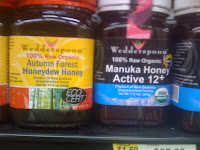Now that I am in culinary school, people are coming to me with all of their pent up kitchen questions as if I were Alton Brown. I admit that I don't know very much (yet), but I think it is a great idea to take your questions back to my teachers and blog about their responses.
Here are two questions a co-worker asked recently, as well as the reponses from my Food Sanitation teacher:
- There is a lot of confusion out there as to whether or not it is safe to microwave something in a plastic container, even if it is labeled as microwave safe, is there any merit to this? What about plastic containers that aren't labeled as microwave safe?
- Answer: There are no concerns when it comes to microwaving something in a plastic container. The biggest risk with heating something up in a non-microwave safe container is the possibility of melting.
- Note: I did some of my own research and it turns out there are plenty of people out there who are concerned about the chemicals from the plastic mixing in with the food during heating. I haven't been able to find any concrete information to back one side or the other yet, but feel free to post any opinions in the comment section regarding your own microwave habits.
- Hypothetically, if you have leftovers from dinner and reheat all of it for lunch the next day, is it safe to then refrigerate any extra leftovers for later use?
- Answer: Nope. Think about how your mom taught you that it is unsafe to thaw a frozen item and then refreeze it for later, you are still giving bacteria time to grow in the food before it goes back into the cold. Refrigeration doesn't kill bacteria, it only prevents it from growing. Even freezing doesn't kill all types of bacteria. (Side note, my teacher had no problem admitting that she does this herself on a constant basis)
- Answer: Nope. Think about how your mom taught you that it is unsafe to thaw a frozen item and then refreeze it for later, you are still giving bacteria time to grow in the food before it goes back into the cold. Refrigeration doesn't kill bacteria, it only prevents it from growing. Even freezing doesn't kill all types of bacteria. (Side note, my teacher had no problem admitting that she does this herself on a constant basis)
Feel free to send in any questions you have and I will make sure to get some answers for you soon!






